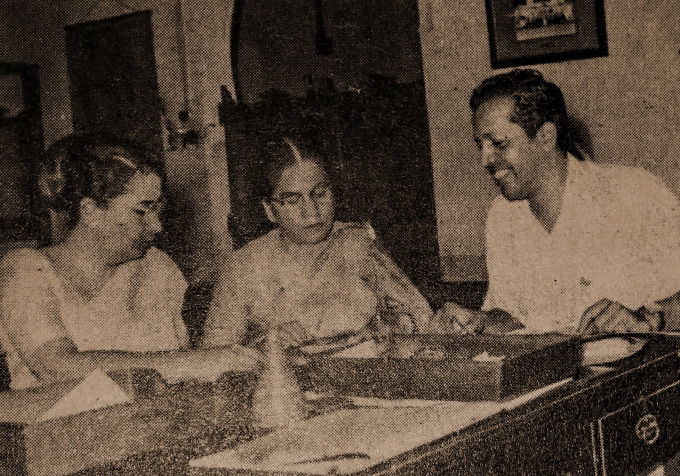‘The Polytechnic Ltd.’ was founded in 1901 by Lawrie Muthu Krishna, an imposing personality. He wore a long coat and waistcoat with winged collar. In keeping with the trend of his generation, he wore his hair long and, like all good Colombo Chetties, he always carried a folded, black umbrella. He was held in high esteem by the business community.

A man of broad vision, he realized the importance of tertiary and vocational education and catered to that need. It was a time when the country’s educational system, based on academic study, was not geared to the realistic labour-market. From humble beginnings as a private business college at San Sebastian Hill on Hulftsdorp, Muthu Krishna set up the Polytechnic, first at Bambalapitiya and then at the present location in Wellawatte.
His sisters, Olive and Violet, having completed their commercial education at the Madras Technical College, joined their brother and were the Poly’s first teachers. At the time, young women who had no interest in pursuing higher studies, found the Poly an ideal institution to hone skills mat would help them to be useful working members of the community, while building up their own careers. The Poly provided courses in communication skills, business correspondence, secretarial management, bookkeeping and accounting – all of which became popular, particularly with young ladies just out of secondary school.
The youngest pupil in my first Journalism Class was a 16-year-old girl from me Holy Family Convent, Bambalapitiya. My oldest student was a 58-year-old man on the eve of his retirement – a barometer of the wide age-group that comprised the Poly’s students.
There were a few other academies and tutories scattered around the city. But the Poly stood out distinctively and was, by far, the most popular. The Poly was unique for two reasons. While other educational institutions were, by and large, denominational, the Poly was non-sectarian. It was also one of the few, if not only, institutions, providing co-education where men and women sat together in the same classroom. The Poly was also considered an alternative to university, and it became trendy for one to say, “I go to the Poly.”
Of course, the Poly was also an excuse for teenagers to get out of their homes. Unsuspecting parents believed their offspring were preparing themselves for a career. But some of the romantically-inclined, playing truant, sought the ‘Savoy’ next door where matinee shows set the scene for stolen kisses.
Shadhara herself, has childhood memories of the institution founded by her forefathers. “I enjoyed my childhood, living next to the Poly,” she says. “I loved to hear the gossip outside our home window which was always packed with Poly students. Of course, they didn’t know I was listening.”
Today, Poly students are scattered around the world, in many professions. I’ve met them in England and Australia. Many are here in Canada. They speak with warmth and affection of the friendships made in their Poly days which have endured over the years.
Some of my own journalism students are doing well in life. Firoze Sameer is a successful businessman and a prolific writer who has authored books, including a documentary on the infamous Ossie Corea – ‘Dossiercorea.’ One of my brightest young sparks, Lalani, the daughter of a former Permanent Secretary, C. J. Serasinghe, is now a legal secretary at the Ministry of Justice. She tells me, “The journalistic skills acquired under your training at the Poly come in very useful in my research presentations, editing legal publications, etc..
At home and abroad, men and women who have passed the portals of the Poly have entered me outside world, armed with confidence. As a tribute to their second ‘Alma Mater’ – if you will – these alumni should band themselves together and proudly proclaim themselves as ‘Poly’s Past Pupils.’
When the sexes meet, the inevitable happens. Romance fills the air. Love blossoms. Hearts meet. Partings leave broken hearts.
From ten thousand miles away, I send greetings to the Polys centennial celebrations, and would wish to conclude this editorial contribution on a personal note that had a happy ending.
My daughter, Chitra, on completing her secondary schooling at the Devi Balika Vidyalaya at Borella, took a secretarial course at the Poly, which landed her, her first job at Heath & Co. While at the Poly, she met Dev, a fellow-student. Their friendship grew. Later, Dev left for Canada to start a new life. Chitra followed him to take him for her life’s partner.
Now, happily married for over a quarter century, and enjoying a stable family life, they have two university-educated daughters, Tamara and Dilani. Chitra herself has risen high in her profession as a banker.
In a real sense, the Poly is responsible for me and the rest of our family making our home in Canada. We followed Chitra instead of going to Australia which we had originally planned to make our home.
In many parts of the world, Sri Lankan expatriates, loyal to their ‘Alma Mater,’ have formed associations of Old Boys and Old Girls – Anandians, Nalandians, Royalists, Thomians, Bridgetians, Visakhians, Josephians, Peterities – the list is endless.
Credit – Kirthie Abeyesekera






Loading…
Loading…